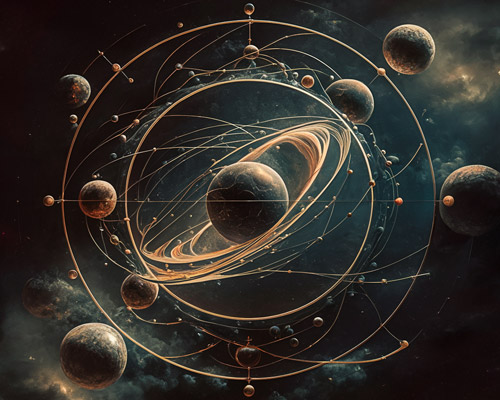Can astrology increase your chances of good luck? What cycles, planets and asteroids may be used in electional astrology to boost your luck? Using the lottery as a research lab, Eskild Rasmussen employs research methods to find statistically significant patterns for successful electional charts.
Purpose and Methods
People nowadays are impatient. They want to see immediate results and proof of concept. Thanks to the Internet, people have become accustomed to fast and easy access to an abundance of information, science is worshipped as a new religion, and utilitarianism (the idea that everything has to be useful in some way) seems to be the most prevalent philosophy.
Astrology does not really fit into this Zeitgeist: Astrology is old, it requires more research and it is not easy to measure its effect. Yet astrology has become increasingly popular among the younger generations.
Forty years ago, when I was running an astrological business and doing radio broadcasts about astrology on a local radio station, people would often joke with me: 'Oh, you are an astrologer? Why don't you help me win the lottery next Saturday?' And then they would laugh. Like most other astrologers I was immersed in the psychological side of astrology, and I would either ignore or reject the suggestion with the rejoinder 'that's not what astrology is about!'
After I stopped having clients in order to dedicate my time to research into astrology, I thought: 'Why not?' It could be an interesting project to examine the degree to which astrology might increase the chances of winning the lottery. In this way I would also be able to accommodate the Zeitgeist.
The astrological branch most suited for this purpose would be electional astrology.
Electional astrology
The most basic definition of astrology is "As above, so below". Throughout the ages, astrologers have created a number of astrological branches for various purposes, e.g. natal astrology, horary astrology, mundane astrology, synastry, financial astrology, etc. Astrology has also evolved differently according to culture, e.g. Western astrology, Chinese astrology, Vedic astrology, etc.
In our age, Western astrology is often viewed from a psychological perspective. Electional astrology is one of the more obscure branches of Western astrology: The selection of an auspicious moment to take action in order to assign good luck to your project. Electional astrology has deep roots; it is described in written sources dating back to the Roman Empire, and was favoured by the Arab astrologers during the Middle Ages. Today electional astrology is mostly used by business astrologers.
Before starting my research project into lotteries, I had mostly used election astrology for travelling. I found out that I could avoid issues related to holiday travel, if I left my home at an astrologically fortunate moment. In order to improve my skills in this area, I began to use election charts on a daily basis by selecting the best moment to leave my apartment when I went to work in the morning. The results were compelling: Usually the chosen election chart reflected my experience of the work day.
The lottery as a laboratory for research
I started to collect election charts for winning lottery tickets in early 2015. In the intervening nine years I have collected 101 election charts for winning lottery tickets based on the time of purchase.
The odds in public lotteries are not good. In Denmark there is on average a win for 1 out of 5 lottery tickets, and in most cases the gain is very small – like winning back the price of 1 lottery ticket.
My collection of 101 election charts for winning lottery tickets led me to determine 144 points: I assigned 1 point to every chart that wins back the money paid for it, and 2 points to each chart where I have doubled the money I paid for the coupon. My collection contains 43 charts for lottery coupons, which have won twice as much or more, as I paid for it. It means that even when the win was 4900% of the price for the coupon, the election chart does not represent more than 2 points.
If you consider lotteries to be a laboratory for astrological research into election charts, then the extremely bad odds become an advantage. If you win back the price you paid for the coupon, then we must surely conclude that the selected moment for buying the lottery ticket was auspicious. The statistically significant discoveries I made in this collection of election charts can be assumed to work in contexts, where the odds are much better, e.g. on the stock market.
Unlike the stock market, a lottery is extremely stable and whenever you win, you can attribute the win entirely to "luck", because unlike the stock market, your prior knowledge about the lottery does not improve your chances of winning.
Perspectives
I have not become a lotto millionaire (yet). Indeed, I have lost money over the years: but that's not the point. Even though it would be nice to make a big win, the main purpose with this project was to harvest astrological knowledge about election charts for financial purposes.
Here I would remind you about Gerolamo Cardano (1501-1576), who was a mathematician and an astrologer. He laid the foundation for the mathematical discipline "probability", and he did it because he was a notorious gambler, who was curious about the chances of winning money in various games. Before Cardano, luck with gambling was attributed to the gods or God. Nowadays Cardano's harvest of probability knowledge is used all over the world by CEOs to assess risks in various business enterprises.
Even though my chart collection is small, it does indeed render statistically significant results. It would surely have been better, if the chart collection had been larger, because then the probability of replicating the results in new counts would be larger. The astrologers of the past did not have a chart collection of this size from which to derive interpretation rules – nor did they have access to computers. My predecessors had to come up with theories about election astrology based on speculation and a few scattered observations, while I have sufficient data to not only verify their theories, but also make new observations. It is my hope that astrologers of the future will replicate my study in order to verify my observations.
Presentation of the research results
My research into election charts for winning lottery tickets is an ongoing project, and any result presented in this article is preliminary. The amount of knowledge I have harvested so far is great and this article can only contain a fraction of it. I hope one day I can present all of it in a book, including the data collection.
My research results break the frames of traditional astrology. It would be impossible to limit the total presentation of these results to the usual astrological elements such as 'planets in signs', 'planets in houses' or 'planets in aspect'. Instead, the statistical methods which I have applied, require a more sophisticated mathematical language, where harmonics (as presented in John Addey's book 'Harmonics in Astrology') play an important role. Outside astrology, harmonics are known as 'Fourrier analysis'.
Some astrologers may find the mathematical or technical presentation of these research results boring, while engineers and software programmers will surely exult with joy.
For the reasons listed here I have limited the presentation in this article to lunar harmonics and lunar aspects. From astrologers of old to those of the present day, all seem to agree that the Moon is the most important planet in electional astrology.
Planetary bodies and aspects used
In this particular research project I wished to explore the planets used in modern Western astrology, a number of asteroids from the asteroid belt, a number of trans-Neptunian objects and the Mean Lunar Node together with Lilith, the Mean Lunar Apogee. The asteroids and the trans-Neptunians were meant to be random samples. The idea was to increase their number along the way, if the statistical results were interesting. However, I discovered that the asteroids would have to be treated as one celestial body, because they move forward with almost the same speed. Something similar appeared to be true for the trans-Neptunians. These phenomena will be explained in further detail later in the text.
The planets used in modern Western astrology are Sun, Moon, Mercury, Venus, Mars, Jupiter, Saturn, Uranus, Neptune, and Pluto.
The asteroids I selected are Ceres, Vesta, Pallas Athena, Hygeia, 2060 Chiron, and 44 Nysa. Chiron is usually labelled an asteroid in astrology, but in fact Chiron is a centaur, which in astronomy is very different from an asteroid in the asteroid belt. I included Nysa, because when I started to do the statistical counting, the astronomers claimed that Nysa was the asteroid with the largest "asteroid family", and I wanted to find out if having a big asteroid family had any significance on the research results. However, the astronomers seem to have changed their mind since then. Now they write: "The Nysa family is part of the Nysa–Polana complex, the largest cluster of asteroid families in the asteroid belt."
The trans-Neptunians I chose for the present research project are (apart from Pluto): Makemake, Eris, Quaoar, Haumea, Gonggong, 84922 and 202421. The last two celestial bodies on the list have not been named officially yet. In order to discern them from each other I took the liberty to give them these ad hoc names for the purposes of this article only: "Iznogoud" (84922) and "Gaston" (202421).
When selecting the asteroids and the trans-Neptunians I did not pay any attention to their mythological names – as many astrologers tend to do. To me the selected asteroids were merely random samples of a specific category of celestial bodies. In general I tend to and prefer to do exploratory research rather than setting up a hypothesis in advance like e.g. "X was associated with good luck in mythology".
According to John Addey’s "Harmonics in Astrology" aspects are merely fractions of the 360° circle. The conjunction is the fraction 1/1, the opposition is the fraction 1/2, the trines are the fractions 1/3 and 2/3, etc. The present project is done very much in John Addey’s spirit, when it comes to the chosen aspects. I have included the first 12 harmonics of aspects. Apart from the aspects already mentioned they include the squares, the quintiles, the sextiles, the septiles (of which there are 6: 1/7, 2/7, 3/7, 4/7, 5/7 and 6/7), the semisquares and the sesquisquares, the noviles (of which there are 6: 1/9, 2/9, 4/9, 5/9, 7/9 and 8/9), the deciles (of which there are 4: 1/10, 3/10, 7/10 and 9/10), the undeciles (of which there 10: 1/11, 2/11, 3/11, 4/11, 5/11, 6/11, 7/11, 8/11, 9/11 and 10/11) and finally the semisextiles and the quincunxes.
The Results
Lunar aspects
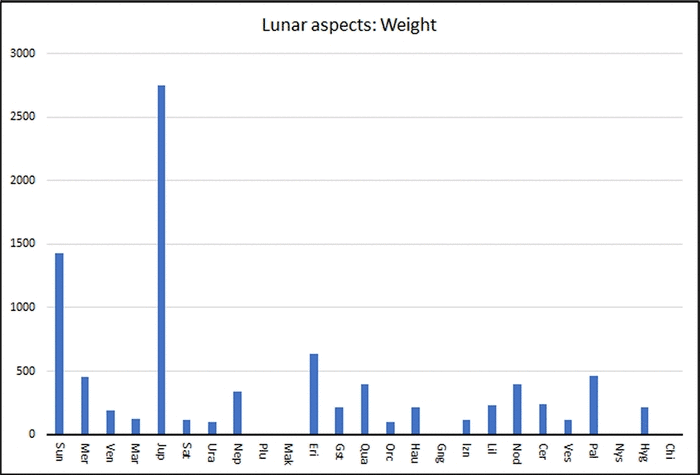
Looking at the graph in Figure 1, it is evident that the Moon's aspects to Jupiter and the Sun are by far the most important aspects in the electional charts for winning lottery tickets. Number 3, 4 and 5 are the dwarf planet Eris, the asteroid Pallas and finally Mercury.
| Planet | Aspect | Percent | Chi-Square | Odds |
|---|---|---|---|---|
| Jupiter | Cnj | 1025 | 84.05 | 20, 728, 894, 254, 448, 000, 000 |
| Jupiter | Tri | 838 | 112.23 | 31, 429, 412, 838, 852, 300, 000, 000, 000 |
| Jupiter | Sxt | 713 | 81.23 | 4, 977, 137, 518, 807, 360, 000 |
| Jupiter | Nov | 171 | 14.01 | 5, 495 |
| Sun | Tri | 775 | 96.10 | 9, 155, 429, 902, 366, 500, 000, 000 |
| Sun | Sxt | 650 | 67.60 | 4, 993, 318, 939, 259, 270 |
| Eris | Squ | 275 | 12.10 | 1, 984 |
| Eris | Qnt | 275 | 24.20 | 1, 151, 645 |
| Eris | Und | -88 | 6.13 | 75 |
The first planet is Jupiter. Among the 144 points representing the entire chart collection, 9 points have the conjunction between the Moon and Jupiter. Only 0.8 points are expected. It means that there is +1025% of these conjunctions. The chi-square calculation renders 84.05, where a score of 3.85 (or 1 : 20) is statistically significant. The probability that this observation has occurred randomly is 1 : 20 quintillion(!)
If you sum up the percentages of Jupiter, you end up with 2,747 as illustrated in the bar diagram. When summing up the percentages, the absolute number is used.
Eris is the only planet with a statistically significant negative percentage, namely -88 for the undecile. The absolute value of -88 is 88.
Most astrologers are familiar with the aspect abbreviations, but some of these aspects might be exotic to others:
- Qnt = Quintile (72° and 144°) – or a 360° circle divided by 5.
- Nov = the family of Noviles (40°, 80° and 160°) – or a 360° circle divided by 9.
- Und = the family of Undeciles – or a 360° circle divided by 11.
Among the 3 most important planets aspected by the Moon, Eris is definitely the most exotic. The statistically significant aspects here are the square (which is considered to be a disharmonious aspect and not expected in this context), the quintile (denoting creativity) and the undecile which has a negative percentage: All these observations are surprising.
Zodiac positions and outer planets
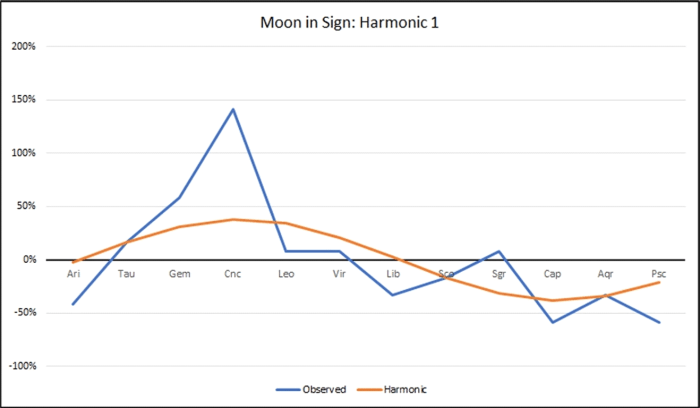
There is clearly more to the lunar distributions than just the 1st harmonic, since the sign of Cancer has 142% more lunar positions than expected! There is also a 2nd harmonic with an amplitude of 46% and a phase in 175° - which translates to two waves with top points in 88° (28° Gemini) and 268° (28° Sagittarius): neatly opposing or conjoining the Galactic Centre.
Analysis of the first 45 harmonics in my search for statistically significant harmonics in the lunar positions, revealed 10 such harmonics.
The question remains: How or why do these lunar harmonics in the zodiac occur? Is the above mentioned 1st harmonic due to something inherent in the zodiac – or is it caused by the Moon's planetary cycle to some distant object like e.g. Pluto?
The data collection spans over a period of only 9 years. During this period Pluto moved from 14° Capricorn to 0° Aquarius. The only way to find an answer to these questions is to analyse the Moon's planetary cycles with the slow planets. In the following I refer to the slow planets as 'the outer planets', even though not all of them are 'planets' by definition.
In this context the outer planets are:
- Chiron – orbital period of 50.71 years
- Uranus – orbital period of 84.02 years
- Neptune – orbital period of 164.8 years
- Pluto – orbital period of 247.94 years
- Makemake – orbital period of 306.21 years
- Eris – orbital period of 559.07 years
- "Gaston" (202421) – orbital period of 283.95 years
- Quaoar – orbital period of 288.83 years
- Orcus – orbital period of 245.19 years
- Haumea – orbital period of 283.12 years
- Gonggong – orbital period of 554.37 years
- "Iznogoud" (84922) – orbital period of 247.64 years
- Spring Equinox – i.e. the zodiac itself!
Analysis of the 1st harmonic in all 13 outer planets gave one outstanding result:
The Moon's 1st harmonic turned out to be statistically significant in relation to all 13 outer planets. The strongest 1st harmonic being this one:
- Eris, 54% amplitude, phase 285° i.e. when Eris is located in the Moon's 10th field, the chances of winning increase by 54%.
The Moon has only one statistically significant 1st harmonic in this data set. This one 1st harmonic appears in a statistically significant way in the zodiac and in the Moon's relationships with the 13 outer planets seen from different angles, i.e. with different phases. These 14 observations do not mean that the Moon has 14 statistically significant 1st harmonics.
Based on these observations we must therefore conclude that it is the dwarf planet Eris, which sets the Moon's 1st harmonic. In the nine years covered in my research, Eris has moved from 22° Aries to 24° Aries. It is the Moon's 1st square to Eris which is favourable for lottery wins, while the Moon's 2nd square to Eris works in an opposite way. (In the simplified cookbook astrology, a square is always a square. In research astrology it is sometimes important to discriminate between the 1st and the 2nd square.)
As a consequence of these observations, we can expect this magical point (i.e. the phase in the 1st harmonic) in the zodiac to move forward in the same pace as Eris moves forward. In 100 years from now we should expect the magical point (or the phase in the 1st harmonic) to be approximately 20° Leo.
To conclude the matter: The astrologers of 100 years into the future will not be able to replicate the initial observation with the Moon's statistically significant 1st harmonic having a phase at 19° Cancer. Instead, they will observe a Moon's 1st harmonic with a phase at 20° Leo. That is because the Moon's statistically significant 1st harmonic is not linked to the zodiac's 0° Aries, instead it is linked to Eris, which is a celestial object that moves slowly forward.
The same is true for the Moon's 2nd harmonic mentioned earlier. We can conclude that the observation about the Moon's 2nd harmonic being 'neatly opposing or conjoining the Galactic Centre' was purely coincidental, because the Moon's 2nd harmonic's amplitude was only 46% in the zodiac, while the Moon's 2nd harmonic with Pluto has an amplitude of 62%. In other words: The Moon's two waves with top points in 88° (28° Gemini) and 268° (28° Sagittarius) will move on forward in the zodiac, because they are linked to Pluto, which is a moving object. They are not linked to or associated with the Galactic Centre.
Only a few of the newly discovered celestial bodies outside Neptune's orbit have been included in this research. Since I did not include all the trans-Neptunians, I cannot exclude the possibility that other celestial bodies have influence similar to the above mentioned influences from Eris and Pluto.
As you can see, in this data collection the outer planets compete with each other for the statistically significant harmonics my research provides. When a harmonic occurs more than once, it must by logic always be the strongest harmonic that causes the harmonic.
Please bear in mind that harmonics and aspects are not the same issue, even though they are related to each other. An aspect has an orb, a harmonic does not have an orb. I chose a very small orb for the aspects, namely 1°, in order to avoid the competition, which I have described as existing when the Moon forms harmonics to the outer planets, including the zodiac itself. The tropical zodiac is defined by the spring equinox, which is equivalent to 0° Aries, and the spring equinox can then be viewed as merely another outer planet within the present research project.
Asteroids in the asteroid belt
The Moon's planetary cycles with the asteroids highlight this on-going difficulty as the asteroids hardly move in relation to each other. I have treated them as if they were one celestial body. If the same harmonic occurs more than once between the Moon and an asteroid, it is the strongest harmonic, which is used.
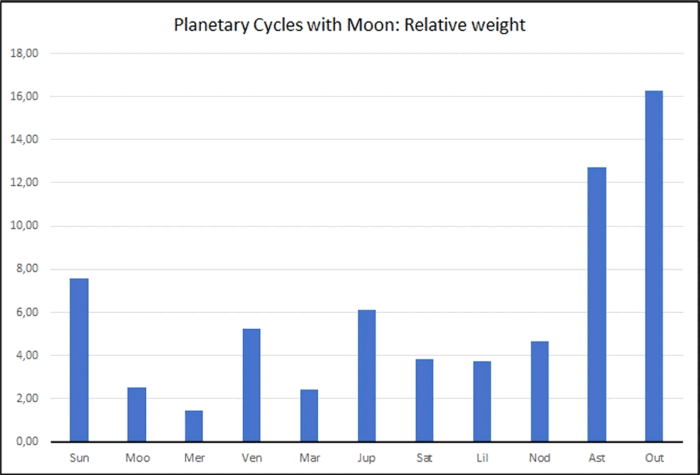
What is important is that when it comes to planetary cycles, the Moon's planetary cycle with the Sun is more important the Moon's planetary cycle with Jupiter. We saw the opposite with the aspects. Furthermore Venus is the Moon's 3rd most important planetary cycle. The Lunar Node and Lilith seem important too.
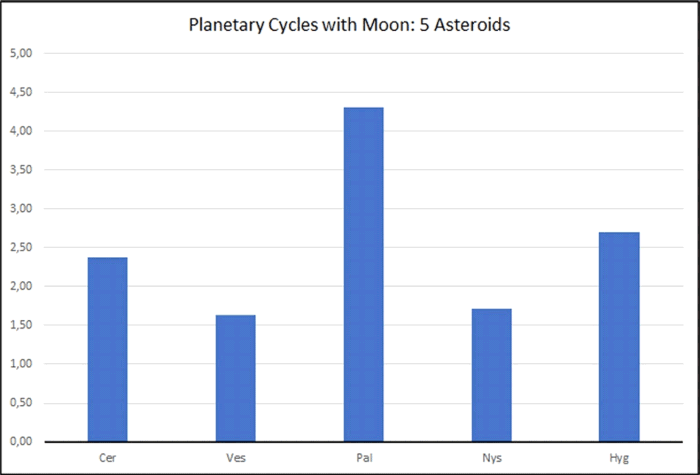
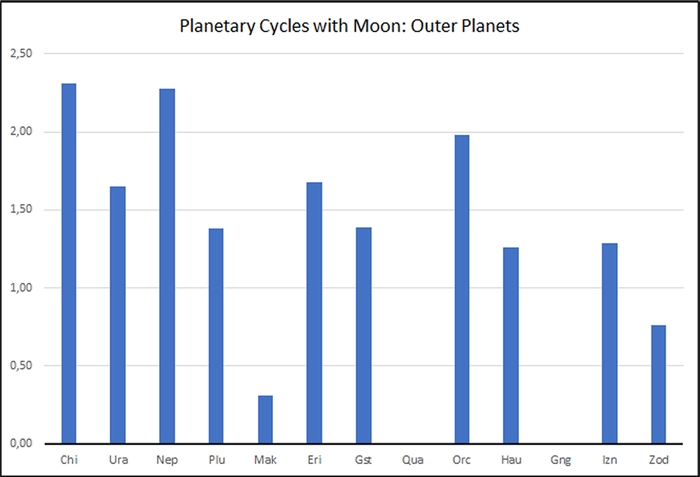
Limitations
In this article I have only presented the Moon's role in the research project, and the presentation has been very superficial. Two other articles may be added:
- Influences from the Sun, Mercury and Venus. (Mars cannot be included because the data collection's time span is too short.)
- The influences from the diurnal circle, which includes not only planetary positions in the diurnal circle but also planetary rulers' positions.
The final presentation of this research should be the publication of a book outlining all research methods.
Application of the discoveries
The purpose with the research is to apply the discoveries from the data collection to future election charts, thereby predicting when to recommend the purchase of a lotto ticket.
The approach has to be "algorithmic", i.e. a step-by-step procedure with separate calculations at each step. The calculations with harmonics are done using sine formula. Once the research phase is over, it should be possible to create an app making it possible to test an electional chart for its financial opportunities.
Such an app would not make an overnight millionaire but increase the probability of winning from 1:5 to 1:4 or maybe even 1:3. I hope it can be a step on the path towards a form of astrology acknowledged by the academic world but also a household tool used by the average John Doe or Jane Doe.
Eskild Rasmussen
Eskild Rasmussen (born 10 January 1962) is a certified software tester (with a BA in computer science in 1997), who has worked with astrology since 1980. In 1989-1992 he was a full-time professional astrologer, teaching, broadcasting in local radio and TV and writing articles and books, of which most are in the Danish language. From 1994 he has worked with astrology research in various forms, e.g. with statistics and using AI (neural networks). He was born in Denmark, where he lives. He spent his childhood in Tanzania, and he has travelled extensively in Africa and Asia. He is inspired by the ancient Greek philosophers, who considered it to be a religious duty to learn as much as possible, to research and to spread information through teaching.

